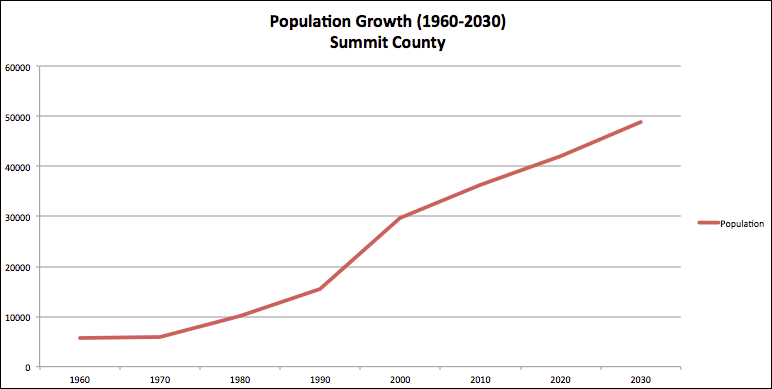Let’s Look At Growth in Summit County Historically
This morning on KPCW’s Local News Hour they were talking growth again. I heard there are 4,000 units of unbuilt density (basically homes) in Park City and about 14,000 in the Snyderville Basin. The theory presented is that because of those rights to build, that people are going to flock to the Park City area. The theory could turn out being right, and if so, that’s a lot of people to add to our area.
Yet, I started thinking about unbuilt density (homes). Weren’t most of those rights to build entitled for a long, long time? Perhaps, instead it makes sense to look at historical population trends and see what is happening in Summit County. Below is a chart of growth since 1960. It uses census data up to 2014 and then extrapolates the future based on the 2010 to 2014 average growth.

![]()
What you’ll see is that the greatest period of growth happened between 1990 and 2000 (92% growth). The second highest growth is 1970 to 1980 (73% growth). You’ll find that 2000-2010 actually ranks fourth in terms of growth (for decades since 1960), with 22% growth. There was only one lower growth decade, between 1960 and 1970 (4%). The results for 2000 to 2010, of course, may have been influenced by the Great Recession. Yet, what has it looked like this decade?
If we extrapolate out the growth we have seen so far this decade, we are at 16% growth for the 2010 to to 2020 period. However, the country hasn’t had a recession since 2009. That is historically unprecedented and therefore its likely there will be a recession in the next five years. Thus, since population growth often slows related to recessions, it is likely this decade will see even less growth than what I extrapolated. It will likely have the slowest growth of any time since 1970.
So what does that tell us? Growth is likely less now than in decades, on a percentage basis (you could also look at a raw population basis, which I’ll try to do later). What we have to ask is if availability of homes drive people to move here (i.e., damn the growth trends, if we build it they will come) or whether populations grow and then they need homes (i.e., it’s the people that want to live here and not the property that matters). I wish I was smart enough to know which it was.
Yet I keep coming back to the fact that a lot of this land was available for homes for a long time. Is it just that the “right” population wasn’t available to move here (or didn’t want to move here) and thus it wasn’t developed? Is there some other factor that has limited building of homes? Perhaps.
Regardless, I think it makes sense to consider population trends as a large factor into our population models that drive political decision in and around Park City. Given those trends maybe we don’t need to rush to convert land to commercial centers to pack in density. Maybe we let land ride as residential (which a lot of it is) and see if what’s past is prologue.

Comments
Leave a Comment